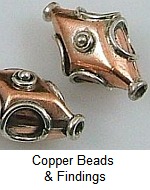Copper Tidbits and Facts
 The use of copper in jewelry making is growing exponentially, resulting in the quest for more knowledge about copper in general. Below I have included snips and links to many interesting articles gathered near and far on the big wide web, touching on various aspects of copper. From mining and the making of wire to some of the many and varied health aspects.
The use of copper in jewelry making is growing exponentially, resulting in the quest for more knowledge about copper in general. Below I have included snips and links to many interesting articles gathered near and far on the big wide web, touching on various aspects of copper. From mining and the making of wire to some of the many and varied health aspects.
As in all jewelry making, use proper safety procedures, read directions where appropriate and work smart. Most important - have an enjoyable experience and make pretty things!
Sherry is constantly updating her information on this subject so after you read this article you can click here to see any revisions. Find my bits of opinion on the subject of tarnishing and green skin in a prior post by clicking here. ~Sherry~ http://sherrysjewels.blogspot.com/
Coppers
The major uses of pure, unalloyed copper are based on its high electrical and thermal conductivity as well its good corrosion resistance. Almost all alloying elements are detrimental to the electrical conductivity of copper, making the purity of the mental an important issue. Commercially pure copper is represented by UNS numbers C10100 to C13000. The various grades of unalloyed copper differ in the amount of impurities and therefore do behave differently. Oxygen free coppers are used in applications requiring high conductivity and exceptional ductility.
click to read more -> http://www.copper.org/resources/properties/microstructure/coppers.html
Copper Production from Ore to Finished Product
4b. Smelting
Several stages of melting and purifying the copper content result, successively, in matte, blister and, finally, 99% pure copper. Recycled copper begins its journey to finding another use by being resmelted.
5b. Electrolytic Refining
Anodes cast from the nearly pure copper are immersed in an acid bath. Pure copper ions migrate electrolytically from the anodes to "starter sheets" made from pure copper foil where they deposit and build up into a 300-pound cathode. Gold, silver and platinum may be recovered from the used bath.
6. Pure Copper Cathodes
Cathodes of 99.9% purity may be shipped as melting stock to mills or foundries. Cathodes may also be cast into wire rod, billets, cakes or ingots, generally, as pure copper or alloyed with other metals.
7. Cathode is converted into:
* Wire Rod - Coiled rod about 1/2" in diameter is drawn down by wire mills to make pure copper wire of all gages.
click to read more -> http://www.copper.org/education/production.html
Copper Circuits Help Brain Function; Could Tweaking the Circuits Make Us Smarter? September 26th, 2006 in Medicine & Health / Research
The flow of copper in the brain has a previously unrecognized role in cell death, learning and memory, according to research at Washington University School of Medicine in St. Louis. The researchers' findings suggest that copper and its transporter, a protein called Atp7a, are vital to human thinking. They speculate that variations in the genes coding for Atp7a, as well as other proteins of copper homeostasis, could partially account for differences in thinking among individuals.
click to read more -> http://www.physorg.com/news78476785.html
Published September 05, 2006 in General Science > Medicine & Health Scientists Find Key to Copper Absorption, Essential to Life
Humans, animals and plants require copper to live, and scientists have now discovered how cells absorb this mineral that fuels the brain, heart and other vital organs.
Knowing how copper enters cells could prove essential to treating copper deficiencies in humans, said the scientists from Duke University Medical Center who made the discovery. People derive copper exclusively from their diet. The mineral is found abundantly in shellfish, legumes, red wine, nuts, seeds and chocolate, among other sources.
Although too much copper is toxic, copper deficiencies in adults can trigger brain deficits, heart enlargement, visual impairment, anemia (low iron), skin and hair breakdown and other organ damage. *snip*
click to read more -> http://www.physorg.com/news76691960.html
Copper Compounds
It is worth noting that copper is an indispensable constituent of all living tissues and is essential for the normal growth and well being of plants and animals. Where it is lacking it has to be supplied. The minute quantities of copper needed for human health are usually obtained through the normal intake of food and water.
Copper and its compounds are not toxic like some other metals, such as lead or mercury. There are no records of any occupational diseases attributable to copper among people who have worked for many years with the metal or its salts. Indeed it has sometimes been said that such people often appear healthier and generally suffer less from colds and other ailments. Copper bangles and other adornments are reputed to relieve and prevent rheumatic pains. Copper water storage vessels, copper kettles and copper cooking pans have been used for generations.
To trace the history of copper compounds it would be necessary to go back much further than the fourth millennium BC. Records found in the tombs of the early Egyptians suggest that, at least, this ancient civilization employed copper sulphate as a mordant in their dyeing process. Today, more than 5,000 years later, copper sulphate is still employed by the world's dyeing industry in the after treatment of certain dyes to improve their fastness to light and washing.
Another equally early recorded use for copper compounds was for the making of ointments and other medical preparations.
click to read more -> http://www.copper.org/applications/compounds/homepage.html
Published: 28 March 2008 Researchers at Southampton University - http://www.soton.ac.uk/ - have established that copper surfaces can inactivate the virulent hospital superbug Clostridium difficile.
C. difficile forms spores which are resistant to a range of disinfectants, including alcohol gel, which is recommended for routine use in hospitals. These spores can live in the environment for a long time and are rapidly becoming a major cause of hospital acquired infections.
Lead researcher Prof Keevil said that the new findings are particularly significant. 'We've already shown that copper surfaces can inactivate MRSA microbes. The fact that we've now established that copper also inactivates C. difficile spores, which are resistant to standard cleaning regimes, doubles our conviction that copper can play a significant role in helping hospitals to fight against infections,' he said.
click to read more -> http://www.cupron.com/Cupron-News-Antimicrobial/
U.S. EPA Approves Registration of Antimicrobial Copper Alloys March 25, 2008 NEW YORK-
The U.S. Environmental Protection Agency (EPA) has approved the registration of antimicrobial copper alloys, with public health claims. These public health claims acknowledge that copper, brass and bronze are capable of killing harmful, potentially deadly bacteria. Copper is the first solid surface material to receive this type of EPA registration, which is supported by extensive antimicrobial efficacy testing.
click to read more -> http://www.copper.org/about/pressreleases/2008/pr2008_March_25.html
Copper's antimicrobial properties have been known for more than five millennia. The ancient Egyptians used copper pipes to transport water to destroy parasites and other water-borne pathogens. Shipbuilders have used copper for thousands of years to keep algae from encrusting on the hulls of ships. French vintners have used a copper sulfate compound to fight fungus on grapevines for hundreds of years.
click to read more -> http://www.cupron.com/Cupron-Technology-Antimicrobial/
More articles not quoted
Copper In Human Health
http://www.copper.org/health/papers/cu_health_uk/cu_health_uk.html
Med Hypotheses. 2008;70(3):610-3. Epub 2007 Aug 6. Could chronic wounds not heal due to too low local copper levels? Borkow G, Gabbay J, Zatcoff RC.
http://www.cupron.com/Articles/Could_chronic_wounds_not_heal_due_to_too_low_local_copper_levels.txt
Copper door handles and taps kill 95% of superbugs in hospitals
http://www.dailymail.co.uk/health/article-1081359/Copper-door-handles-taps-kill-95-superbugs-hospitals.html
COPPER ON SKIN - CULTURAL BELIEFS, SCIENTIFIC DATA, ESOTERIC IDEAS - by Sergio Lub* 1995
http://www.sergiolubcanada.ab.ca/cos.html
Reference Materials PEER-REVIEWED PAPERS
http://www.cupron.com/Cupron-Reference-Materials/
August 14, 2008 Cupron Delivers Copper-Based Technology Products from Israel and North Carolina
https://www.aiccse.org/Newsletter/NewsletterPreview.aspx?NewsletterID=68
~~This article is copyright. You can not reprint this article since it links to so many outside sources unless you keep all the links active and as long as the original author is sited and a link to their site and this website is included. The name Magpie Gemstones must be used as the hypertext and link to the home page.~~








